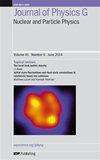非微扰状态下假真空的命运
IF 3.5
3区 物理与天体物理
Q2 PHYSICS, NUCLEAR
Journal of Physics G: Nuclear and Particle Physics
Pub Date : 2024-01-18
DOI:10.1088/1361-6471/ad170e
引用次数: 0
摘要
我们利用标量场理论的一些精确结果,修正了科尔曼和卡伦关于假真空衰变的分析,并提出了一种简单的非微扰形式主义。我们引入了一个精确的格林函数,它包含了理论强耦合状态下的非微扰修正。标量场理论的解涉及雅可比椭圆函数,并被用于计算任意耦合值的有效势。我们在一个简单的 λϕ4 理论中演示了这一形式主义的使用,并证明有效势在原点处显示了一个虚假的最小值。然后,我们计算了薄壁近似中的假真空衰减率,并提出了简单的解析公式,这些公式可能有助于分析超越微扰机制的一阶相变。在我们的方法论中,我们表明通过将耦合值变得非常小,可以重现在微扰理论中获得的标准结果。本文章由计算机程序翻译,如有差异,请以英文原文为准。
Fate of false vacuum in non-perturbative regimes
We use some exact results in scalar field theory to revise the analysis by Coleman and Callan about false vacuum decay and propose a simple non-perturbative formalism. We introduce an exact Green’s function which incorporates non-perturbative corrections in the strong coupling regimes of the theory. The solution of the scalar field theory involves the Jacobi elliptical function and has been used to calculate the effective potential for any arbitrary coupling values. We demonstrate the use of this formalism in a simple λ
ϕ
4 theory, and show that the effective potential exhibits a false minimum at the origin. We then calculate the false vacuum decay rate in the thin wall approximation, and suggest simple analytic formulae that may be useful for the analysis for the first-order phase transition beyond the perturbative regime. In our methodology, we show that the standard results obtained in perturbation theory are reproduced by making the coupling values very small.
求助全文
通过发布文献求助,成功后即可免费获取论文全文。
去求助
来源期刊
CiteScore
7.60
自引率
5.70%
发文量
105
审稿时长
1 months
期刊介绍:
Journal of Physics G: Nuclear and Particle Physics (JPhysG) publishes articles on theoretical and experimental topics in all areas of nuclear and particle physics, including nuclear and particle astrophysics. The journal welcomes submissions from any interface area between these fields.
All aspects of fundamental nuclear physics research, including:
nuclear forces and few-body systems;
nuclear structure and nuclear reactions;
rare decays and fundamental symmetries;
hadronic physics, lattice QCD;
heavy-ion physics;
hot and dense matter, QCD phase diagram.
All aspects of elementary particle physics research, including:
high-energy particle physics;
neutrino physics;
phenomenology and theory;
beyond standard model physics;
electroweak interactions;
fundamental symmetries.
All aspects of nuclear and particle astrophysics including:
nuclear physics of stars and stellar explosions;
nucleosynthesis;
nuclear equation of state;
astrophysical neutrino physics;
cosmic rays;
dark matter.
JPhysG publishes a variety of article types for the community. As well as high-quality research papers, this includes our prestigious topical review series, focus issues, and the rapid publication of letters.

 求助内容:
求助内容: 应助结果提醒方式:
应助结果提醒方式:


